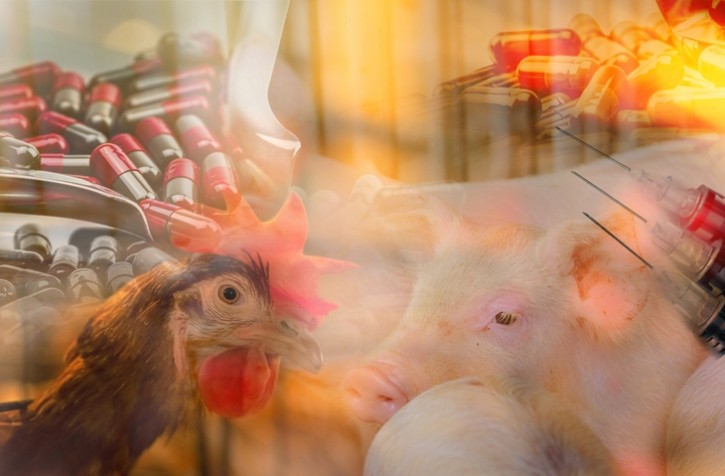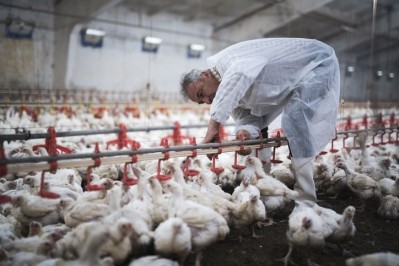WOAH: Use of antimicrobials for growth promotion must be completely phased out globally

Almost 20% of WOAH participating countries still report using antimicrobials for growth promotion. Of these, it is estimated that 76% have not carried out any preliminary risk analysis, said the global entity.
More worryingly, no less than 11% of those countries still use as growth promoters at least one of the highest priority critically important antimicrobials for human medicine such as colistin, reported WOAH yesterday.
And at least 50% of the participating nations using antimicrobials as growth promoters have no regulatory framework in place, it continued.
And the organization noted that, in some countries, the labelling of certain feed additives intended to increase productivity does not mention the presence of low doses of antimicrobials, which are then unknowingly administered to animals by veterinarians and farmers. Such practices are not in compliance with WOAH international standards or the global action plan on antimicrobial resistance (AMR).
“Competent authorities and the livestock industry must fulfil their responsibilities to phase out the use of antimicrobials for growth promotion in animals.”
They should explore and promote alternatives to improve animal productivity, as relevant, said the organization. It has been collecting data on the amounts and reasons for antimicrobial use in animals since 2015.
WOAH standards make a clear distinction between veterinary medical use of antimicrobials – which is limited to the treatment, control and, where appropriate, prevention of infectious diseases – and non-veterinary medical use. The administration of antimicrobials for growth promotion in animals is a non-veterinary medical use, and it must not be assimilated to disease prevention use, which requires animals to be at proven risk of disease if the medicine is not administered.
Slashing the use of antibiotics in poultry farming
The German Federal Ministry of Food and Agriculture is providing funding for a research project focused on the reduction of antibiotic use in poultry farming while maintaining animal welfare.
The project is being run by Julia Steinhoff-Wagner, professor of animal nutrition and metabolism at the Technical University of Munich (TUM), in collaboration with Dr Celine Heinemann, the Institute of Animal Science, at the University of Bonn.
They are exploring how up-to-date scientific knowledge on antibiotic minimization, animal health and the spread of resistance can be transported into practice.
Commenting on the research goals, Steinhoff-Wagner told FeedNavigator:
"Our project primarily serves the transfer of knowledge to improve the health status of the broiler. A good health status guarantees that antibiotics are no longer needed. First and foremost, we will use systematic reviews to summarize and evaluate existing studies as well as attempt to convert them into recommendations for action."
The team, she continued, will undertake a neutral, evidence-based assessment of probiotics, prebiotics, phytogenics, acidifiers, and other feed additives as well as measures to improve feeding hygiene and water quality. "In addition, there are some research questions that we want to clarify with the help of the data from our demonstration farms, such as the connection between zinc and copper in feed and excreta and the resistance status in the farm. The trace metals are suspected of promoting co-resistance.”
A greater level of awareness around their dangers have helped reduce the use of antibiotics in broiler production in Germany since 2014. “Despite this, their overall use remains higher in comparison with other livestock species.”
Livestock density, she argues, is a critical factor in terms of addressing antibiotic reduction objectives. “If more space is available, the bacterial load is lower.”
In an earlier project, Steinhoff-Wagner and others were able to demonstrate that resistant microorganisms were transferred from the parents to the chicks and arrive at the farm with them.
Resistant microorganisms, though, can also transfer around the animals through the water pipelines and the fodder if the cleaning is inadequate.
“Resistant germs are particularly prone to hide in the pipelines. This can be prevented by using the ‘in and out’ method which is widespread in Germany, and in which all the animals in a compartment or a barn or the entire herd are only ever moved from one place to the next simultaneously. If the barn is empty in the time between its use by the groups of animals, it is possible for everything, including the pipeline systems, to be cleaned and disinfected.
“If germs find their way into the herd and the animals are sick, farmers are obliged by the Animal Welfare Act to provide them with treatment. Due to the large livestock holdings in poultry farming, all animals usually must be treated. Resistant germs then have a selective advantage. They are able to survive their contact with the antibiotics and continue to spread.”
Improving gut health in young pigs
University of California (UC) Davis associate professor, Yanhong Liu, researches feed-based technologies to reduce the need for antibiotics while improving animal health and curbing post-weaning diarrhea in pigs.
The stress of moving, the process of assimilating with pen mates and the abrupt change from a liquid diet to solid feed that comes with weaning makes piglets susceptible to bacterial infections such as E. coli
“Our goal is to use nutrition to make pigs more resistant to enteric infection,” she said. “Once they are infected with a bacterial pathogen, antibiotics are the only cure. So, we’re researching feed additives and gauging their effectiveness in promoting growth, improving gut health and overall, in preventing illness.”
A paper that Liu and colleagues published in the Journal of Animal Science indicated that by adding the probiotic Bacillus subtilis to weaned piglet feed, the researchers were able to reduce severe cases of post-weaning diarrhea by as much as 5% and improve the growth of the young pigs by as much as 20%. Furthermore, there were no observable side effects.
Liu’s lab found the probiotic Bacillus subtilis is related to an uptick in beneficial bacteria in the ileum – the final portion of the small intestine – where the pathogenic E. coli reside. Consequently, the improved gut microbial community (Jinno et al. 2022) and bacterial metabolites (He et al., 2021) contribute to the speedy recovery of pigs from post-weaning diarrhea.
She and her team are now weighing up other solutions to decrease E. coli infections and improve swine morbidity rates. Because pathogenic E. coli must attach to a pig’s small intestine before the disease can develop, her research team is looking at ways of heading the attachment off at the pass.
Specifically, the team is focusing on a specially crafted polymer that’s based on the naturally occurring oligosaccharides that are found in pigs with Type A blood. The oligosaccharides are effective in reducing E. coli attachment to the pigs’ intestines. Thus, pigs fed with this special oligosaccharide have lower rates of diarrhea. The researchers believe that if the lab-created polymer can effectively interfere with the initial attachment of E. coli and rapidly eliminate the harmful bacteria from the gut, the infection might be avoided.















